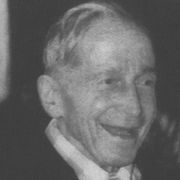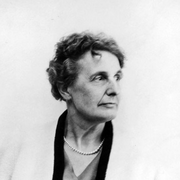Righteous Among the Nations - Irena Sendler
“The kids went in a group of four, dressed in their finest clothes. They walked with Dr. Korczak, holding the dolls that were made for them with love, and what was waiting for them was the Zyklon B. It affected me profoundly. I was devastated. Soon we realized that the only way to save these children is by getting them out of here.”
Irena Sendler
In Pawiak prison in Poland, sits a young woman named Irena Sendler. She lifts her gaze to a small window that served as the only light in her little cell. She sees a thin ray of light and smiles, while only one thought goes through her mind; “They won’t get my children”.
Irena Sendler was born in Otwock, Poland in 1910.[1] Her father was a doctor, and his kindness and the relations he had with his patients, no matter whether poor or wealthy, Christian or Jewish, influenced her life.[2] As an adult, Irena decided to learn social work in Warsaw.[3]

Mieszkowska, Anna. Die Mutter der Holocaust-Kinder: Irena Sendler und die geretteten Kinder aus dem Warschauer Ghetto. Deutsche Verlags-Anstalt, 2006
In 1939, when Poland was conquered by Germany, the Third Reich imposed a reign of terror, fear, and violence. At that time, Irena was working as a senior social worker in the Warsaw Social Welfare Department. This department operated offices all over the city, which provided food, financial help, and other welfare services to orphans, the elderly, and the poor. Later, the department also took care of basic products for the Jewish community. In order to prevent the German authorities from finding out about the departments support, the Jews had to register for aid under Christian names.[4]
In 1942, ‘Żegota’, the Council to aid Jews was established. It included Poles and Jews who worked together to save thousands of lives.[5] Irena Sendler was one of the first to join the council, and her primary role was to save Jewish children from Nazi persecution.[6] After the establishment of the Warsaw ghetto, Irena got special permission to enter it due to her position as a senior social worker in Warsaw. With that permission, she smuggled clothes, medicines, and money into the ghetto.[7] When she entered the ghetto, as a sign of solidarity, she wore a yellow star. Once, Irena forgot to take off the star, and she was harshly beaten by a German officer.[8]
In September 1943, Irena was chosen to lead the Żegota's department responsible for Jewish children. Operating under the alias Jolanta, Irena used her knowledge and connections to find a sanctuary for the children in religious institutions, orphanages, and Polish families.[9] As a young mother herself, she knew the hardship of separating children from their parents, especially because she couldn’t guarantee their safety. She smuggled children out of the ghetto by ambulances, hid them in bags, sometimes in body bags, under piles of food, and on one occasion she even hid a baby under a toolbox. After she smuggled the children out, Żegota issued them false identity papers, and Irena found a safe place for them to hide. In that way, she managed to save 2,500 children.[10]

Mazzeo, Tilar J. Irena's Children: The Extraordinary Story of the Woman Who Saved 2,500 Children from the Warsaw Ghetto. First Gallery Books hardcover edition., Gallery Books, 2016
As head of the department, she was the only one who knew all the details about the children, and their new locations. She made a list of all their names and details, so she could unite them with their families when the time would come. Irena wrote the details in code, so only she could understand in case someone would find her list. The lists were hidden in jars under an apple tree in her neighbor’s house.[11]
In October 1943, the Gestapo arrested Irena, and she was sent to Pawiak Prison in Warsaw.[12] There, she was interrogated and tortured, but she didn’t reveal anything. The Gestapo sentenced her to death for her insubordination.[13] The Żegota council tried to come up with a plan to save her, as she was the only one who knew all the details about the children, and where they were hiding.[14] After several failed attempts to save her, they eventually succeeded in bribing a Gestapo officer who faked her execution. After she got out of prison, Irena was no longer able to use her connections and was forced to continue operating in the shadows to save more children.[15]
When the war ended, Sendler finally retrieved the jars from underneath her neighbor’s apple tree and began to track the relatives of the children who were scattered around Europe. Unfortunately, many of them had died in the Nazi concentration and death camps.[16]

אנה מיישקובסקה, "היא נתנה להם חיים- אירנה סנדלר, האמא של ילדי גטו ורשה", דביר (2009)
On the 19th October 1965, Irena Sendler was recognized by Yad Vashem as a Righteous Among the Nations.[17] In 1983, Sendler visited Israel, and planted a tree in the ‘Avenue of the Righteous’ in Jerusalem. On that occasion, she met many of the children who survived the war thanks to her, accompanied by their families.[18] In 1991, she was granted Israeli honorary citizenship, and in 2003, she received the prestigious Order of the White Eagle award in Warsaw.[19] [20]

אנה מיישקובסקה, "היא נתנה להם חיים- אירנה סנדלר, האמא של ילדי גטו ורשה", דביר (2009)
[1] בתיה דביר (עורכת), השמיעיני קולך ונסו הצללים ( מורשת, בית עדות ע"ש מרדכי אנילביץ ויד ושם, רשות הזיכרון לשואה ולגבורה, המכון הבינלאומי לחקר השואה, 2018) עמ' 291.
[2] Raymond, Jennings. Holocaust Saviours: True Stories of Rescuers That Save Holocaust Refugees. 2nd edition (Place of publication not identified: Publisher not identified, 2015) p. 52.
[3] בתיה דביר (עורכת), השמיעיני קולך ונסו הצללים, עמ' 291.
[4] Raymond, Jennings, Holocaust Saviours: True Stories of Rescuers That Save Holocaust Refugees, p. 52.
[5] קרמיש יוסף, "פעולה של המועצה לעזרת היהודים ( מועצת "ז'גוטה") בפולין הכבושה", ניסיונות ופעולות הצלה בתקופת השואה, (ירושלים, ניסן תשל"ד - אפריל 1974) עמ' 306.
[6] Raymond, Jennings, Holocaust Saviours: True Stories of Rescuers That Save Holocaust Refugees, p. 52.
[7] בתיה דביר (עורכת), השמיעיני קולך ונסו הצללים, עמ' 291.
[8] אנה מיישקובסקה, היא נתנה להם חיים-אירנה סנדלר, האמא של ילדי גטו ורשה (כנרת, זמורה- ביתן, דביר: 2009) עמ' 73-74.
[9] Krakowski, et al, The Encyclopedia of the Righteous Among the Nations: Rescuers of Jews During the Holocaust; Poland (Yad Vashem: 2004) p. 702.
[10] Raymond, Jennings, Holocaust Saviours: True Stories of Rescuers That Save Holocaust Refugees, p. 53.
[11] Ibid, p. 54.
[12] אנה מיישקובסקה, היא נתנה להם חיים-אירנה סנדלר, האמא של ילדי גטו ורשה, עמ' 159-163.
[13] בתיה דביר (עורכת), השמיעיני קולך ונסו הצללים, עמ' 291.
[14] אנה מיישקובסקה, היא נתנה להם חיים-אירנה סנדלר, האמא של ילדי גטו ורשה, עמ' 165.
[15] שם. עמ' 169-170.
[16] Raymond, Jennings, Holocaust Saviours: True Stories of Rescuers That Save Holocaust Refugees, p. 55.
[17] Krakowski, et al, The Encyclopedia of the Righteous Among the Nations: Rescuers of Jews During the Holocaust; Poland, p. 702.
[18] אנה מיישקובסקה, היא נתנה להם חיים-אירנה סנדלר, האמא של ילדי גטו ורשה, עמ' 223.
[19] בתיה דביר (עורכת), השמיעיני קולך ונסו הצללים, עמ' 291.
[20] Raymond, Jennings, Holocaust Saviours: True Stories of Rescuers That Save Holocaust Refugees, p. 56.





